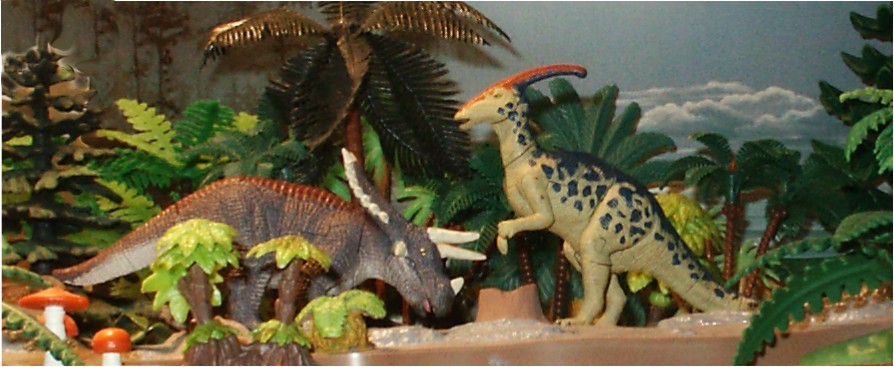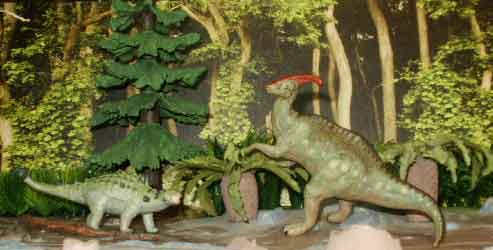
Late Cretaceous Maastrichtian
Kirtland Formation New Mexico
from the Dinosaur Collector
The Kirtland succeeds the Late Campanian (Judithian) Fruitland fauna. The Kirtland Formationin the San Juan Basin of northwestern New Mexico was originally named by Bauer (1916) as the Kirtland Shale. The fauna is intermediate in diversity and composition between the coastal plain fauna of the Fruitland formation and the inland vertebrate upper Kirtland fauna later in the Maastrichtian. This lower, Early Maastrichtian fauna contains at least 9 dinosaurs. Pentaceratops, Parasaurolophus, Struthiomimus, Albertosaurus, Kritosaurus the rare Aublysodon, indeterminate nodosaurid and ankylosaurid probably Euoplocephalus and Edmontonia plus scrappy finds of small dromesaurid, hyilophidontid and pachycephlasaurid. update 091208
Pentaceratops (five horn face )was 34 feet long with a skull of 18 feet that held the record for largest skull in a land animal. Recent Torosaurus finds exceed it, but not by much. . The frill is very elaborate when compared to the later Triceratops. It fades out in the early part of the Maastrichtian when the fauna changes.

Pentaceratops and Parasaurolophus series 5 from FameMaster 4D puzzles. Figures through the generosity of the Dinosaur Farm.
Parasaurolophus fossils have been found in groups of three to four animals. Fragmentary fossils have be assigned to it even late in the Maastrichtian but like all crested duck bills it seems to decline.

Repainted Parasaurolophus and Euoplocephalus from Carnegie Safari.
The Parasaurolophus crest has been suggested as a snorkel or trumpet. There isn't a breathing hole so it isn't a snorkel. It could have made a noise like a French horn that would have been useful for calling mates or marking territory. Parkosaurus was a small plant eater. The small biped plant eater niche lasted through the whole Mesozoic. They were most common in arid or stressed environments. They all looked pretty similar externally.

Parasaurolophus and Euoplocephalus from Carnegie Safari, Battat and Wild Safari Parasaurolophus, Bullyland and Schleich Parasaurolophus.
The small pacycephalosaur Sphaerotholus "round dome" probably resembled Prenocephale. There are also indeterminate dromaeosaurid fossil finds. Most of the small fauna is based on scrappy material.

Battat Euoplocephalus and Edmontonia. Euoplocephalus eclipsed the traditional Ankylosaurus in most museum lines because it was much better known. With new research being published we are seeing Ankylosaurus again being produced.
return to Mesozoic Menu
Click on the Site A icon to the right for Dioramas organized by period or by manufacturer.